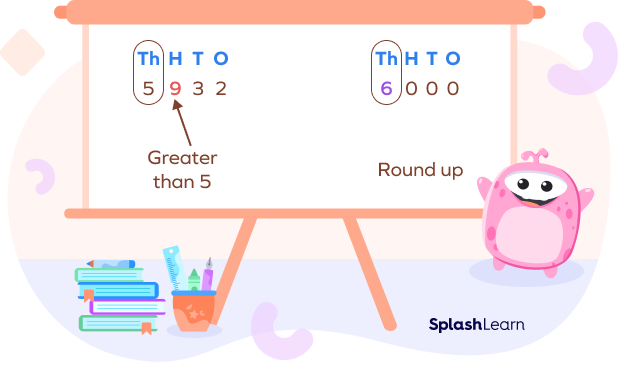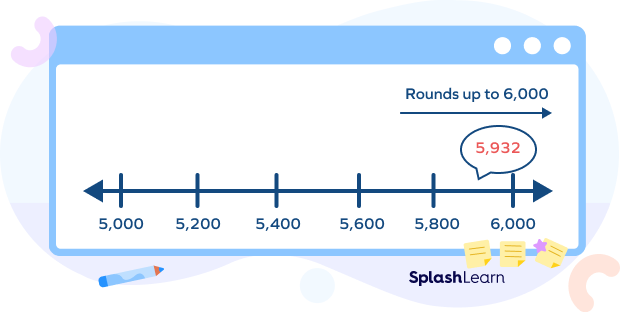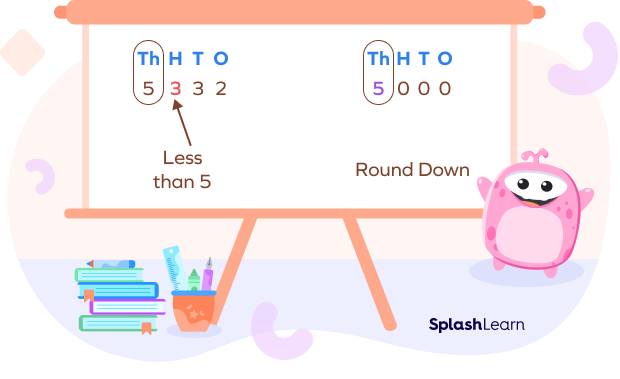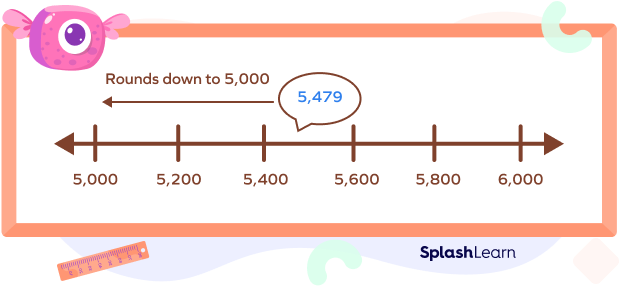What Is Rounding to the Nearest Thousand?
Rounding a number to the nearest thousand means finding the multiple of 1000 closest to the given number.
Rounding a number to the nearest place value simply means replacing the given number by an approximate value, which is simple to understand, yet closer to the original number.
Example: Alex walked 11,568 steps on Monday. Isn’t this number difficult to remember or even to say out loud? However, by rounding it to the nearest 1000, we can simply say that Alex walked about 12000 steps on Monday. The resultant number is simpler and easier to understand.

Recommended Games
Meaning of Rounding to the Nearest Thousand
Rounding the number to the nearest thousand means finding an estimated value that is a multiple of 1000 and closest to the number.
Thus, the new number is closer to the original number, but since it is a multiple of 1000, it is more convenient to use and easy to remember.
To round a number to the nearest thousand, we have certain rules. Before we dive into it, let’s quickly revise the place value chart with the help of the previous example. It will help us in applying the rules.
11,568 can be written in the place value chart as follows:
| Ten Thousands | Thousand | Hundreds | Tens | Ones |
| 1 | 1 | 5 | 6 | 8 |
And 11,568 rounded to the nearest thousand is 12000. Note that 12000 is a simpler representation, which is a multiple of 1000 closest to 11,568.
Recommended Worksheets
How to Round to the Nearest Thousand
Rounding to the nearest thousand depends on the hundreds digit in the place value chart, which is the digit next to the thousands place. The number is rounded up or down based on the value of the digit at the hundreds place and two simple rules.
- Find the place value you are rounding to, which is the thousands place in this instance. Check the digit right next to it, which is the hundreds place. It will guide us on how to proceed.
- If the hundreds digit < 5, the thousands digit does not change.
- If the hundreds digit 5, the thousands digit is increased by 1.
- All the digits to the right change to 0.
Rules for Rounding Numbers to the Nearest Thousand
Note that the following rules are applicable only while rounding the number to the nearest thousand.
Mark the thousands place and note down the digit that is on its immediate right. In other words, note down the digit at the hundreds place.
Rule 1: If the digit at the hundreds place is less than 5, do not change the digit at the thousands place. Replace all the digits to the right of the thousands place by 0.
The final answer is less than the given number.
Example: Round to the nearest thousand: 2456
The digit at the hundreds place is 4, which is less than 5.
| Th | H | T | O |
| 2 | 4 | 5 | 6 |
We do not change the digit at the thousands place, which is 2. Also, we replace all the digits to its right by 0.
So, 2456 rounded to the nearest thousand is 2000.
Note that it is less than 2456.
Rule 2: If the digit at the hundreds place is 5 or greater than 5, add 1 to the digit at the thousands place. Replace all the digits to the right of the thousands place by 0.
The final answer will be greater than the given number.
Example: Round to the nearest thousand: 2576
The digit at the hundreds place is 5.
| Th | H | T | O |
| 2 | 5 | 7 | 6 |
So, we add 1 to the thousands place digit.
$2 + 1 = 3$
We replace all the digits to its right by 0.
2576 rounded to the nearest thousand will be 3000.
Note that it is greater than 2576.
What Is Rounding up and Rounding Down?
When we round a number, the final result after rounding is either greater than or less than the original number. As we discussed in the rules, it depends on the place values. Thus, rounding a number to the nearest place value consists of rounding up or rounding down.
In case of rounding the number to the nearest thousand, if the final number after rounding is greater, then it is termed as rounding up. If the final number is less than the original value, then it is termed as rounding down.
5845 rounds up to 6000.
5231 rounds down to 5000.
Rounding Up
Mark the thousands place. Check the digit at the hundreds place (the digit to the immediate right). If it is greater than or equal to 5, round up, i.e., increase the digit at the thousands place by 1. Replace all the digits to the right of it by 0.

On the number line, we can visualize this as:

Rounding Down
Mark the thousands place. Observe the digit on its immediate right, which is the hundreds place. If it is less than 5, round down. Do not change the digit at the thousands place. Replace all the digits to the right of it by 0.

Let’s take another example to visualize rounding down on a number line.
5479 rounded to the nearest thousand is 5000 since the digit at the hundreds place is 4, which is less than 5.

Facts Related to Rounding to the Nearest Thousand
- The rounding off of numbers is often used in estimation, and measurement calculations where approximation is allowed.
- Storekeepers often round off the amount to avoid dealing with change.
- Rounding off is generally avoided where high accuracy is required.
Conclusion
In this article, we learned how to round to the nearest thousand, rules for rounding up and rounding down along with examples for each case. Let’s solve a few examples and practice problems for better understanding.
Solved Examples on Rounding to the Nearest Thousand
1. Round 429,713 to the nearest thousand.
Solution:
| HTh | TTh | Th | H | T | O |
| 4 | 2 | 9 | 7 | 1 | 3 |
Identify the digit at the hundreds and thousands place.
The digit at the hundreds place is 7, and at the thousands place, we have 9.
Since 7 is greater than 5, we round up.
Add 1 at the thousands place.
$429 + 1 = 430$
Replace the digits to the right with 0.
429713 rounded to the nearest thousand will be 430000.
2. Round to the nearest thousand: 424213
Solution:
| HTh | TTh | Th | H | T | O |
| 4 | 2 | 4 | 2 | 1 | 3 |
Hundreds place digit = 4 < 5. So, we round down.
The digit at the thousands place will remain the same, followed by zeros, resulting in 424,000.
3. Round to the nearest thousand: 9413
Solution:
| Th | H | T | O |
| 9 | 4 | 1 | 3 |
The hundreds digit here is 4. It is less than 5.
Thus, we round down.
9413 rounded down to the nearest thousand is 9000.
Practice Problems on Rounding to the Nearest Thousand
Round to the Nearest Thousand - Definition, Rules, Examples
What is 20,862 rounded to the nearest thousand?
The digit at hundred’s place $= 8$, which is greater than 5. So, we round up.
20,862 rounded to the nearest thousand is 21,000.
Identify the rule used in rounding: $2130 \rightarrow 2000$?
The number is decreased from the original value. Also, the digit at hundreds’s place is 1, which is less than 5.
Round to the nearest thousand: 56,017 and 7,894,234.
According to the rule of rounding down,
$56,017 \rightarrow 56,000$
$7,894,234 \rightarrow 7,894,000$
Frequently Asked Questions on Rounding to the Nearest Thousand
Why does rounding the number decrease its accuracy?
Rounding the number leads to an increase or decrease of the final number from its actual value. The operations, depending on exact numbers, may result in failure. It also negatively affects the statistical significance of data.
How to avoid errors while calculating the rounding to the nearest thousand?
Use the place value chart to organize the digits according to their place values. Identify the digits at the thousands and hundreds place. Finally, apply the rules for rounding up or rounding down.
How to teach rounding?
You can start with identifying place values and rounding to the nearest ten. You can also use a number line to visualize the concept.
What is rounding decimals to the nearest thousandth?
In decimals, the third place to the right of the decimal point is the thousandths place. To round decimals to the nearest thousandth, identify the thousandths place. Check the digit next to it, which is the ten thousandths place. If it is less than 5, round down to the thousandth digit. If it is greater than or equal to 5, round up to the thousandth digit.
For example, 23.5678 rounded to the nearest thousandth is 23.568.




































